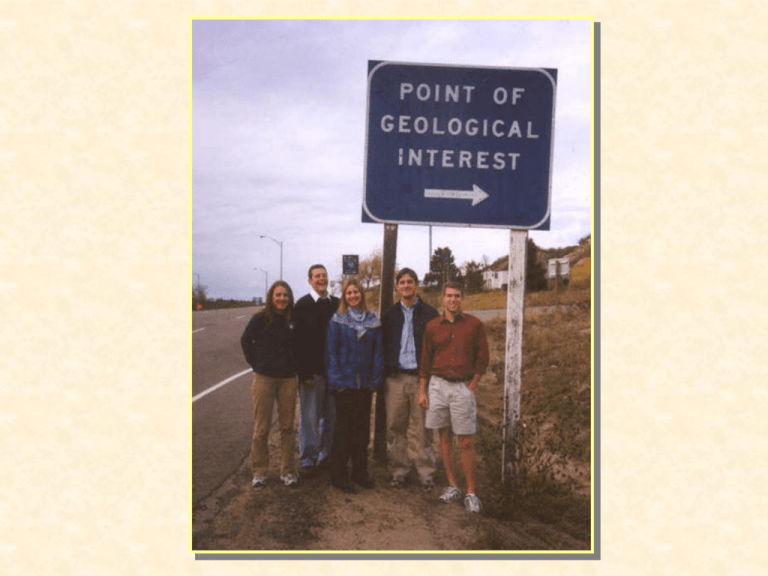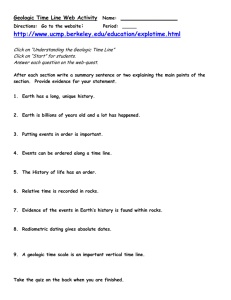Folds, Faults and Mountain Belts (Con't.)
advertisement

METAMORPHISM AND METAMORPHIC ROCKS COMMON METAMORPHIC ROCKS Classified on the presence or absence of FOLIATION. FOLIATION is the parallel alignment of tabular minerals in the rock due to heat and pressure. Gneiss Foliated Quartzite Nonfoliated METAMORPHISM AND METAMORPHIC ROCKS COMMON METAMORPHIC ROCKS Some metamorphic rocks can be produced from a number of parent rocks, i.e., gneiss. They are then distinguished by their appearance and the conditions under which they form rather than by composition. Others form from specific parent rocks, i.e., slate. METAMORPHISM AND METAMORPHIC ROCKS COMMON METAMORPHIC ROCKS METAMORPHIC GRADE describes the severity of metamorphism. Designated low, medium and high grade. The higher the metamorphic grade, the less similar is the metamorphic rock to the original parent rock. METAMORPHISM AND METAMORPHIC ROCKS Foliated Nonfoliated Metamorphic Rock Parent Rock GrainSize Metamorphic Grade Slate Shale Fine Low Phyllite Shale Fine Low Schist Basalt, greywacke, Shale, impure ls. Medium Medium to High Gneiss As in schist, but also felsic igneous rocks Coarse High Marble Limestone or Dolomite Varies Low Quartzite Quartz Sandstone Varies Low to High Anthracite Coal Peat Varies Low to High Greenstone Basalt Varies Low to High METAMORPHISM AND METAMORPHIC ROCKS COMMON METAMORPHIC ROCKS METAMORPHISM AND METAMORPHIC ROCKS USES OF METAMORPHIC ROCKS Building and foundations Road and railroad construction (slate and quartzite) Art - Sculpture (marble) Fire protection (asbestos) Sinks and counters (soapstone) Powder (talc) Metal ores (from metamorphism) TELLING TIME GEOLOGICALLY Time is a critical ingredient to most geologic processes. Geologic time has an immense vastness. We have 4.6 BILLION years to work with. (info comes from the moon and meteorite) To us a decade is a long time! Lots of events happen in this interval of time. How big is a billion? Consider 1,000,000,000 seconds. 1,000,000,000 seconds equals 31.71 YEARS! TELLING TIME GEOLOGICALLY Earth processes do occur rapidly. Earthquakes, landslides, volcanic eruptions, floods and meteorite impacts. Most take place slowly. Opening of ocean basins, mountain building, differentiation of the Earth. This section will focus on the timing of geologic events and the ages of Earth materials. This process is called GEOCHRONOLOGY. TELLING TIME GEOLOGICALLY GEOCHRONOLOGY generally can’t be done to precise instants in time. Dates will typically have errors applied (+/-). Geologists use a variety of clocks for geochronology. They include trees, fossils, and radioactive isotopes to start with. TELLING TIME GEOLOGICALLY GEOLOGIC TIME in PERSPECTIVE Appearance of first Hominids Demise of the Dinosaurs First Land Plants First Fish First Shelled Invertebrates First Appearance of Life Oldest Known Earth Rocks Age of the Earth 3-4,000,000 yBP 65,000,000 yBP 483,000,000 yBP 505,000,000 yBP 570,000,000 yBP 3,770,000,000 yBP 3,960,000,000 yBP 4,600,000,000 yBP TELLING TIME GEOLOGICALLY GEOLOGIC TIME in PERSPECTIVE Appearance of first Hominids Demise of the Dinosaurs First Land Plants First Fish First Shelled Invertebrates First Appearance of Life Oldest Known Earth Rocks Age of the Earth 4 mm 65 mm 483 mm 505 mm 570 mm 3,770 mm 3,960 mm 4,600 mm TELLING TIME GEOLOGICALLY GEOLOGIC TIME in PERSPECTIVE Appearance of first Hominids Demise of the Dinosaurs First Land Plants First Fish First Shelled Invertebrates First Appearance of Life Oldest Known Earth Rocks Age of the Earth 3-4,000,000 yBP 65,000,000 yBP 483,000,000 yBP 505,000,000 yBP 570,000,000 yBP 3,770,000,000 yBP 3,960,000,000 yBP 4,600,000,000 yBP TELLING TIME GEOLOGICALLY GEOLOGIC TIME in PERSPECTIVE We have the dates of these events carefully calculated, or so we want you to believe. How was it done? At first it was done by RELATIVE DATING. RELATIVE DATING compares two or more features and/or events to determine relative age, i.e., which came first, which is youngest. TELLING TIME GEOLOGICALLY GEOLOGIC TIME in PERSPECTIVE RELATIVE DATING TELLING TIME GEOLOGICALLY GEOLOGIC TIME in PERSPECTIVE As science and technology advanced we were able to put actual dates on these features and events. This process is termed NUMERICAL or ABSOLUTE DATING. Requires care in application. ABSOLUTE would indicate that we know absolutely when events occurred. WE DON’T!!! Numerical dates always represent a range within a margin of error. TELLING TIME GEOLOGICALLY PRINCIPLES OF RELATIVE DATING A REVIEW TELLING TIME GEOLOGICALLY PRINCIPLES OF RELATIVE DATING PRINCIPLE OF UNIFORMITARIANISM James Hutton discovered that Earth processes acted over a long period of time (1830s). Hutton proposed that the physical, chemical and biological processes observed on a daily basis, have also acted on the Earth over very long periods of time. Observations of current geological processes could be used to interpret the rock record of very old geologic events. TELLING TIME GEOLOGICALLY PRINCIPLES OF RELATIVE DATING Superposition - The scientific law stating that in any unaltered sequence of rock strata, each stratum is younger than the one beneath it and older than the one above it, so that the youngest stratum will be at the top of the sequence and the oldest at the bottom. Superposition, con’t. With tilted beds, we need to consider other sedimentary structures, like ripple marks, mudcracks, graded bedding, or cross-bedding to help determine up direction. Can also use vesicles in lava flows. TELLING TIME GEOLOGICALLY PRINCIPLES OF RELATIVE DATING Principle of Original Horizontality - The scientific law stating that sediments settling out of a fluid (air and water) are deposited horizontally or nearly horizontally in layers that lie parallel or nearly parallel to the Earth’s surface. Photo by Kevin Hefferan Badlands National Park TELLING TIME GEOLOGICALLY PRINCIPLES OF RELATIVE DATING Principle of Cross-Cutting Relationships - The scientific law that states an igneous intrusion or geologic structure is always younger than the rock that surrounds it. TELLING TIME GEOLOGICALLY PRINCIPLES OF RELATIVE DATING Principle of Inclusions - The scientific law stating that rock fragments contained within a larger body of rock are always older than the surrounding body of rock. TELLING TIME GEOLOGICALLY GEOLOGIC TIME in PERSPECTIVE We have the dates of these events carefully calculated, or so we want you to believe. How was it done? At first it was done by RELATIVE DATING. RELATIVE DATING compares two or more features and/or events to determine relative age, i.e., which came first, which is youngest. TELLING TIME GEOLOGICALLY GEOLOGIC TIME in PERSPECTIVE RELATIVE DATING TELLING TIME GEOLOGICALLY GEOLOGIC TIME in PERSPECTIVE As science and technology advanced we were able to put actual dates on these features and events. This process is termed NUMERICAL or ABSOLUTE DATING. Requires care in application. ABSOLUTE would indicate that we know absolutely when events occurred. WE DON’T!!! Numerical dates always represent a range within a margin of error. TELLING TIME GEOLOGICALLY PRINCIPLES OF RELATIVE DATING FOSSILS FOSSILS are any evidence of past life. Used with other principles to figure out the order in which life developed, changed and went extinct. Very hard to accomplish. Hard to establish life history for organisms. Only 1% of all species that ever lived have been preserved as fossils. TELLING TIME GEOLOGICALLY PRINCIPLES OF RELATIVE DATING FOSSILS To be preserved, fossils require special conditions. Include: Rapid burial Hard parts Most organisms don’t have hard parts. TELLING TIME GEOLOGICALLY PRINCIPLES OF RELATIVE DATING PRINCIPLE OF FAUNAL SUCCESSION If we know the position of each rock layer in a sequence, we know their relative age. Then, if we look a the fossils in the layers, we can determine the relative ages of them. This sequence will occur again and again in the geologic record. Can then be used to provide relative age of the rocks. TELLING TIME GEOLOGICALLY PRINCIPLES OF RELATIVE DATING PRINCIPLE OF FAUNAL SUCCESSION TELLING TIME GEOLOGICALLY PRINCIPLES OF RELATIVE DATING PRINCIPLE OF FAUNAL SUCCESSION Generally we use INDEX FOSSILS for this approach. INDEX FOSSILS have short lifespan (rapid evolution) widespread geographic distribution and are easy to recognize TELLING TIME GEOLOGICALLY RELATIVE DATING BY WEATHERING RINDS Relative ages of rocks can be determined by comparing the extent of weathering preserved in them. Weathering will produce a RIND of weathered material at or near the rock’s surface. Produced in a variety of ways. TELLING TIME GEOLOGICALLY RELATIVE DATING BY WEATHERING RINDS The longer the length of exposure to weathering, the thicker the rind. Thickness of soil can also be used in this manner. (Need to use similar soils produced from similar parent rocks)





